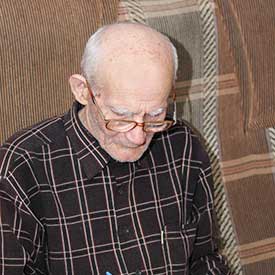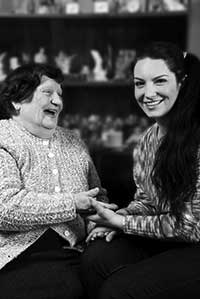
- Elder Abuse is any action or inaction by self or others that jeopardizes the health or well being of the individual.
- Elder Abuse cases are likely to increase as the percentage of older adults in the population increases (baby boomer retirees between 2011-2036
- Elder Abuse is a part of family violence that is often overlooked.
Prevalence of Abuse
- In a 2008 Canadian survey, 5% of seniors surveyed reported they had experienced abuse (Human Resources and Social Development Canada).
- 18% of Albertans knew an elder who had experienced abuse (Alberta Elder Abuse Awareness Network)
- Who is abused?
- It can be ANY senior
- Most are mentally competent but have some measure of cognitive impairment
- Both men and women
- Rich and poor alike
- Happens within all cultures
- Who are the Abusers?

- Someone who:
- the seniors knows, loves, trusts
- is able to influence elder
- is often dealing with their own issues – financial, addiction, mental health, poor interpersonal skills
- typically a family member, adult child
- Factors making a senior more vulnerable to abuse:
- Senior has por physical health
- mental health concerns (senior and abuser)
- cognitive decline
- low income of the abuser
- housing issues (abuser cannot maintain housing or senior does not want to live in a supportive care facility)
- caregiver stress (experienced by abuser or senior)
- loneliness (abuser or senior)
- lack of natural or professional supports (abuser or senior)
- poor interpersonal skills (abuser or senior)
The following statistics were collected in 2012, in the Edmonton area, by the Elder Abuse Intervention Team.
Types of Elder Abuse
Financial (61%)
- Misuse of the elder’s funds or property through fraud or trickery, manipulation, repetitious begging, stealing, misuse of debit/credit cards and joint accounts.
Emotional/Psychological (54%)
- Takes the form of verbal aggression, humiliation, intimidation, isolation, name calling, blaming, belittling, manipulation, threatening, controlling behavior, withholding love.
Physical (20%)
- Physical force causing discomfort or injury– slapping, shaking, punching, pushing, failure to provide adequate health care, and causing property damage, throwing objects causing injury, assault with a weapon.
Sexual (1%)
- Unwanted forms of sexual activity or behaviors – fondling, verbal/suggestive behaviors, lack of personal privacy, unnecessary help with dressing/hygiene, sexual intercourse with an elder unable to give consent, beign forced to perform degrading acts.
Neglect (13%)
- Intentional or unintentional failure to provide for the elder’s needs. Denial of social contact, abandonment
- Failure to provide:
- safe/warm place to live
- personal hygiene
- proper food/clean clothing
- services to meet senior’s necessities of life
- aids to daily living – hearing aids, mobility aids, bath aids
- medical attention to injuries, infections, bed sores or routine appointments
Medication (2%)
- Misuse of medications or prescriptions
- Withholding/non-compliance with refills
- Overmedicating/sedation
 Factors in Abuse…
Factors in Abuse…
- History of spousal abuse - a continuation of domestic violence
- Family dynamics - if family interactions were unhealthy in early life or if an abused child becomes a primary caregiver
- Isolation - elder becomes isolated due to physical and/or mental illness or loss of friends and/or family – makes it easier for abuser to exploit elder
- Inability to cope - due to the stress of long-term caregiving out of a sense of duty or pressure
- Senior exhibits poor interpersonal skills (inability to say “no”)
Barriers to Disclosure:
- Fear, shame, guilt
- Hopelessness/loneliness, feelings of helplessness
- Love of abuser
- Medication disability/mental impairment
- Language or cultural difference
- Inappropriate medication
- Unaware of social services, law enforcement, and community support services available
- Acceptance of abuse as normal
What Are Clues?
Any of the following might be a clue that abuse is happening.
In the case of emotional abuse:
- Elder may seem frightened, withdrawn, depressed or apathetic, nervous, scared, low self-esteem, crying, anxiety
- Often reports or witnesses yelling, name calling, inability to make contact with the senior, repetitious statements/theats
In the case of physical abuse:
- Unusual marks/injuries that do not correlate with the story
- Indication of weapon used, marks in unusual places (on the trunk of body including head, back, stomach, between toes, buttocks)
- Senior may display fear, shame, pain, confusion (head injury), mood changes including depression and anxiety
In the case of sexual abuse:
- Bruising/pain around genitalia
- Fear of being touches
- Crying of other changes in mood including depression or anxiety
- Shame, fear
In the case of financial abuse:
- Unexplained sale of property
- Items missing from the home (and money)
- Someone else cashing pension cheques
- Bank account over-drawn
- Unexplained transactions of seniors account
- Excessive money giving, large withdrawls
- Sudden changes to Wills, Land Titles, Assets, Power of Attorney documents
- Elder maybe stressed, confused, have anxiety
In the case of neglect:
- Decreased social contact
- Abandonment
- Seems groggy or alterned consciousness
- Seems thin or appears to have lost a lot of weight
- Wearing dirty clothes or inappropriate closes for the season
- Not having aids to daily living (dentures, mobility aids, glasses, etc)
- Obvious medical issue not being attended to
What can you do?
 Who might the elder report abuse to…
Who might the elder report abuse to…
- Family members
- Friend or neighbour
- Healthcare worker
- Service provider (in-home or facility)
- Program staff
- Faith leader
- Social worker
- Police
- Any supportive person that is trusted
- Elder Abuse experts
Express concern for senior’s safety and offer to link to help when…
- An elder discloses information or a suspicious statement is made
- Injuries or events are reported or witnessed that don’t match explanations
Support the senior in getting help with… (Note: Linking to help may break the cycle of abuse and the senior can have a say in what they want done about the abuse).
- Safety plan
- Finding resources/referrals
Alert someone who can help with elder abuse concerns such as
- Police
- Elder Abuse Resource and Supports (EARS) – EARS links high risk cases to the Elder Abuse Intervention Team (EAIT)
- Facility management
NOTE: If the matter is an emergency call 911 and ask for immediate police or medical assistance.
Elder Abuse Services for Edmonton
Edmonton City Police (non-emergency number) 780-423-4567
Elder Abuse Edmonton Police Service Constable 780-496-871 (criminal concerns)
Elder Abuse Resource and Supports 780-477-2929 extension 1
(also receives high risk referrals for the Elder
Abuse Intervention Team (EAIT)
Police and Crisis Team (mental health) 780-482-0222
(Police and RN/RPN or Social Worker)
Seniors Abuse Helpline (24 hr support line) 780-454-8888
Office of the Public Guardian 780-422-1868
Office of the Public Trustee 780-427-2744
Protection of Persons in Care Act (PPICA) 1-888-357-9339
SAFE Senior Safe House 780-702-1520 extension #3
Alberta Elder Abuse Awareness Network
(Supports outside of Edmonton)
Other Related Resources
Directory of Seniors Services Seniors Association of Greater Edmonton
(any community service related to seniors)\
Book:
“Elder Abuse – What is it? What can be done about it?” – by Community Action committee on Elder Abuse
Oak-Net – Older Adult NKowledge Network (information about Canadian Law)
